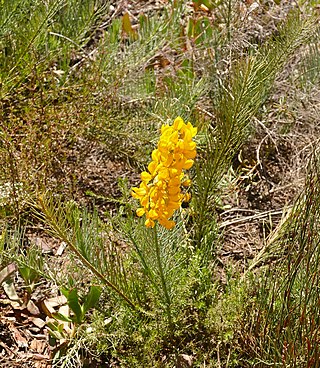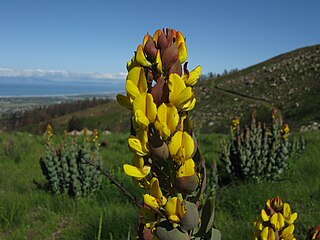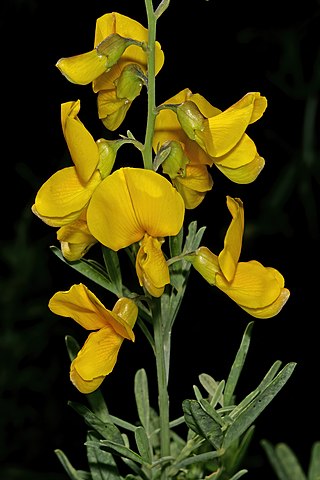
Indigofera is a large genus of over 750 species of flowering plants belonging to the pea family Fabaceae. They are widely distributed throughout the tropical and subtropical regions of the world.

Lebeckia is a genus of plants in the family Fabaceae native to the fynbos of South Africa. Several members of Lebeckia were recently transferred to other genera. Members of Lebeckia are known to produce pyrrolizidine alkaloids, including ammodendrine, lebeckianine, and lupanine.

Lotononis is a genus of flowering plants in the family Fabaceae and the tribe Crotalarieae. Almost all of the species in the genus occur in southern Africa.
Leobordea mirabilis is a known species of legume in the family Fabaceae. It is exclusive to Namibia. Its natural habitat is rocky areas.

Melolobium is a genus of 15 species of flowering plants belonging to the family Fabaceae. It is native to southern Africa, where it is found in south and east Namibia, southwest Botswana, and most of South Africa.

Crotalarieae is a tribe of flowering plants belonging to the family Fabaceae. It includes rooibos (Aspalathus linearis), harvested for sale as a tisane.

Amphithalea is a genus of flowering plants in the family Fabaceae. It belongs to the subfamily Faboideae.

Argyrolobium is a genus of flowering plants in the family Fabaceae. It belongs to the subfamily Faboideae. Members of this genus are found in Africa and south Asia.

Aspalathus is a genus of flowering plants in the family Fabaceae. The yellow flowers and spiny habit of some species have suggested a resemblance to Ulex europaeus, the thorny "English gorse" Accordingly, "Cape Gorse" has been proposed as a common name although the resemblance is largely superficial; for instance, gorse is thorny, whereas Aspalathus species are variously spiny or unarmed. The genus belongs to the subfamily Faboideae. There are over 270 species, mainly endemic to southwestern fynbos regions in South Africa, with over fifty occurring on the Cape Peninsula alone. The species Aspalathus linearis is commercially important, being farmed as the source of Rooibos tea.

Podalyria is a genus of flowering plants in the family Fabaceae. It belongs to the subfamily Faboideae. The genus is endemic to South Africa.

Rafnia is a genus of flowering plants in the family Fabaceae. It belongs to the subfamily Faboideae.

Xiphotheca is a genus of flowering plants in the legume family, Fabaceae. It belongs to the subfamily Faboideae. The name of the genus is a compound of Ancient Greek ξίφος (ksíphos), which means "sword", and θήκη (thēkē) which can mean "box" or "sheath"—a reference to the shape of the legume pods. Members of this genus can be distinguished by:
"(1) the presence of bracteoles in most species; (2) the fusion of the bracts with the base of the pedicel; (3) the laterally compressed pods; and (4) the accumulation of anabasine as a major alkaloid."

Calobota is a genus of flowering plants in the legume family, Fabaceae. It belongs to the subfamily Faboideae.












